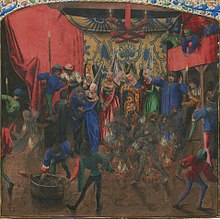This is an old revision of this page, as edited by Victoriaearle (talk | contribs) at 23:30, 11 November 2011 (caption). The present address (URL) is a permanent link to this revision, which may differ significantly from the current revision.
Revision as of 23:30, 11 November 2011 by Victoriaearle (talk | contribs) (caption)(diff) ← Previous revision | Latest revision (diff) | Newer revision → (diff)
The Bal des Ardents (Ball of the Burning Men) was a ball organized by Charles VI of France on 28 January 1393, which turned to tragedy, causing the deaths of four of his companions.
On January 28, 1393, Charles' wife Queen Isabeau held a masquerade at the Hôtel Saint-Pol to celebrate the third marriage of one her ladies-in-waiting. Traditionally a woman's remarriage was an occasion for mockery and foolery, celebrated with masques, discord, and disguises.
Huguet de Guisay suggested that Charles and some of his knights appear in a costumed dance. The knights disguised themselves as wood savages, in costumes made of linen soaked in resin to which flax was attached "so that they appeared shaggy and hairy from head to foot", and attaching themselves with chains. They covered their faces with masks made of similar materials. To prevent an accident in the combustible costumes, torches were kept out of the hall during their appearance.

After they were presented, musicians started to play. Guests began to dance on the sound of trumpets, flutes, chalumeaus and musical instruments. The men capered about pretending, howled like wolves, spat obscenities as the by-standers attempted to guess the identity of each dancer. Arriving late and carrying torches, Charles' brother, Louis I, Duke of Orléans and Phillipe de Bar, caused one of the costumes to catch fire from a spark. According to one contemporary description, "the Duke of Orleance...put one of the Torches his servants held so neere the flax, that he set one of the Coates on fire, and so each of them set fire on to the other, and so they were all in a bright flame.
The costumes of all the disguised dancers caught fire. Only the Queen knew her husband the King was among the dancers. She fainted as the men began to burn. Charles was standing at a distance from the other men near the 15-year-old Duchesse de Berry who saved his life by throwing her skirt over his costume. A second dancer, Sire de Nantouillet, survived by throwing himself in a wine cask. In their attempts to rescue the dancers and stop the flames, many guests were burned. The Count de Joigny died on the spot; Yvain de Foix and Aimery Poitiers lingered painfully for days. Huguet de Guisay lived for three days, ranting and raving, near madness.
The mythology of wildmen or forest men were closely associated with demonology in the medieval period, and by the time of Isabeau's masque, the folkloric depiction of wildmen had become an acceptable theme in noble society. The masque itself is considered by scholars to be a form of courtly theater which may or may not have encouraged audience participation. The Duchess of Berry's actions have been described variously as participatory or not; she either pulled him out of the dance to speak with her, or he stepped away to speak to her. Froissart's chronicles that "The King, who proceeded ahead of , departed from his companions...and went to the ladies to show himself to them...and so passed by the Queen and came near the Duchess of Berry"
References
- ^ Tuchman, Barbara. A Distant Mirror: The Calamitous 14th Century. New York: Ballantine, 1979. pp. 504-505
- qtd in MacKay, Ellen. Persecution, Plague, and Fire. Chicago: University of Chicago Press, 2011
- Heckscher, William. The Art Bulletin. Vol. 35, No. 3, p. 241
- Stock, Lorraine Kochanske. Review of The Performance of Self: Ritual, Clothing, and Identity during the Hundred Years War by Susan Crane. Speculum , Vol. 79, No. 1 (Jan., 2004), pp. 159-160